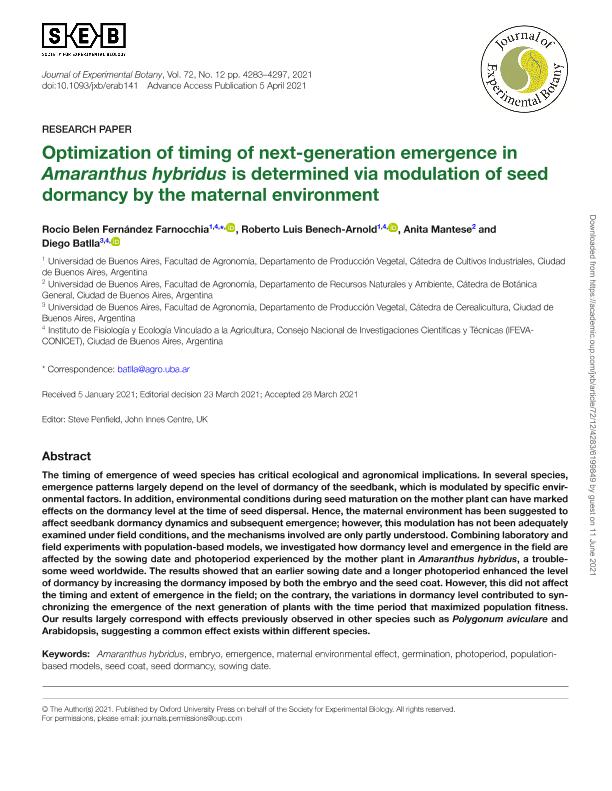Mostrar el registro sencillo del ítem
dc.contributor.author
Fernández Farnocchia, Rocio Belen
dc.contributor.author
Benech-Arnold, Roberto Luis

dc.contributor.author
Mantese, Anita Ida

dc.contributor.author
Batlla, Diego

dc.date.available
2022-09-12T16:16:44Z
dc.date.issued
2021-05
dc.identifier.citation
Fernández Farnocchia, Rocio Belen; Benech-Arnold, Roberto Luis; Mantese, Anita Ida; Batlla, Diego; Optimization of timing of next-generation emergence in Amaranthus hybridus is determined via modulation of seed dormancy by the maternal environment; Oxford University Press; Journal of Experimental Botany; 72; 12; 5-2021; 4283-4297
dc.identifier.issn
0022-0957
dc.identifier.uri
http://hdl.handle.net/11336/168385
dc.description.abstract
The timing of emergence of weed species has critical ecological and agronomical implications. In several species, emergence patterns largely depend on the level of dormancy of the seedbank, which is modulated by specific environmental factors. In addition, environmental conditions during seed maturation on the mother plant can have marked effects on the dormancy level at the time of seed dispersal. Hence, the maternal environment has been suggested to affect seedbank dormancy dynamics and subsequent emergence; however, this modulation has not been adequately examined under field conditions, and the mechanisms involved are only partly understood. Combining laboratory and field experiments with population-based models, we investigated how dormancy level and emergence in the field are affected by the sowing date and photoperiod experienced by the mother plant in Amaranthus hybridus, a troublesome weed worldwide. The results showed that an earlier sowing date and a longer photoperiod enhanced the level of dormancy by increasing the dormancy imposed by both the embryo and the seed coat. However, this did not affect the timing and extent of emergence in the field; on the contrary, the variations in dormancy level contributed to synchronizing the emergence of the next generation of plants with the time period that maximized population fitness. Our results largely correspond with effects previously observed in other species such as Polygonum aviculare and Arabidopsis, suggesting a common effect exists within different species.
dc.format
application/pdf
dc.language.iso
eng
dc.publisher
Oxford University Press

dc.rights
info:eu-repo/semantics/openAccess
dc.rights.uri
https://creativecommons.org/licenses/by-nc-sa/2.5/ar/
dc.subject
AMARANTHUS HYBRIDUS
dc.subject
EMBRYO
dc.subject
EMERGENCE
dc.subject
GERMINATION
dc.subject
MATERNAL ENVIRONMENTAL EFFECT
dc.subject
PHOTOPERIOD
dc.subject
POPULATION-BASED MODELS
dc.subject
SEED COAT
dc.subject
SEED DORMANCY
dc.subject
SOWING DATE
dc.subject.classification
Agricultura

dc.subject.classification
Agricultura, Silvicultura y Pesca

dc.subject.classification
CIENCIAS AGRÍCOLAS

dc.title
Optimization of timing of next-generation emergence in Amaranthus hybridus is determined via modulation of seed dormancy by the maternal environment
dc.type
info:eu-repo/semantics/article
dc.type
info:ar-repo/semantics/artículo
dc.type
info:eu-repo/semantics/publishedVersion
dc.date.updated
2022-08-23T20:53:20Z
dc.journal.volume
72
dc.journal.number
12
dc.journal.pagination
4283-4297
dc.journal.pais
Reino Unido

dc.journal.ciudad
Oxford
dc.description.fil
Fil: Fernández Farnocchia, Rocio Belen. Universidad de Buenos Aires. Facultad de Agronomía. Departamento de Producción Vegetal. Cátedra de Cultivos Industriales; Argentina. Consejo Nacional de Investigaciones Científicas y Técnicas. Oficina de Coordinación Administrativa Parque Centenario. Instituto de Investigaciones Fisiológicas y Ecológicas Vinculadas a la Agricultura. Universidad de Buenos Aires. Facultad de Agronomía. Instituto de Investigaciones Fisiológicas y Ecológicas Vinculadas a la Agricultura; Argentina
dc.description.fil
Fil: Benech-Arnold, Roberto Luis. Universidad de Buenos Aires. Facultad de Agronomía. Departamento de Producción Vegetal. Cátedra de Cultivos Industriales; Argentina. Consejo Nacional de Investigaciones Científicas y Técnicas. Oficina de Coordinación Administrativa Parque Centenario. Instituto de Investigaciones Fisiológicas y Ecológicas Vinculadas a la Agricultura. Universidad de Buenos Aires. Facultad de Agronomía. Instituto de Investigaciones Fisiológicas y Ecológicas Vinculadas a la Agricultura; Argentina
dc.description.fil
Fil: Mantese, Anita Ida. Universidad de Buenos Aires. Facultad de Agronomía. Departamento de Recursos Naturales y Ambiente; Argentina
dc.description.fil
Fil: Batlla, Diego. Consejo Nacional de Investigaciones Científicas y Técnicas. Oficina de Coordinación Administrativa Parque Centenario. Instituto de Investigaciones Fisiológicas y Ecológicas Vinculadas a la Agricultura. Universidad de Buenos Aires. Facultad de Agronomía. Instituto de Investigaciones Fisiológicas y Ecológicas Vinculadas a la Agricultura; Argentina
dc.journal.title
Journal of Experimental Botany

dc.relation.alternativeid
info:eu-repo/semantics/altIdentifier/doi/http://dx.doi.org/10.1093/jxb/erab141
dc.relation.alternativeid
info:eu-repo/semantics/altIdentifier/url/https://academic.oup.com/jxb/article/72/12/4283/6199849
Archivos asociados
